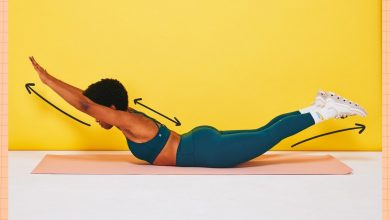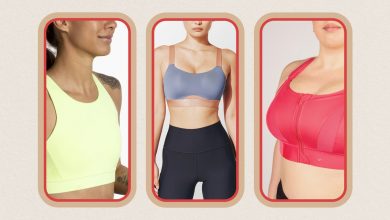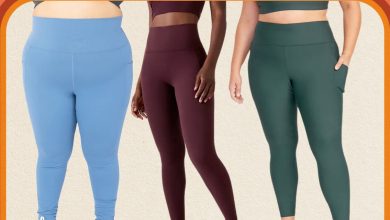The Best Walking Shoes for Wide Feet, According to Podiatrists

How to tell if you have wide feet
If standard-width shoes feel uncomfortable, meaning they chafe, pinch, or rub against the sides of your foot, that’s a sign that you need wider shoes, Brianna Albers, DPM, a podiatric surgery specialist based in Matthews, North Carolina, tells SELF. She adds that bulging and stretching along the sides of your footwear can also indicate that they’re too narrow for you.
The best way to determine your foot width is to have a professional—like a podiatrist or an employee at a specialty shoe store—measure it for you, Dr. Borchardt says. They’ll be able to tell you if you should look for wide, extra-wide, or XX-wide shoes. You can also check your foot’s width at home by standing on a ruler or tape measure in bare feet and measuring your foot at its widest point, Dr. Albers says. She recommends referring to that measurement when browsing brands’ sizing guides to make sure you choose the right width.
How to choose the best walking shoes for wide feet
Knowing your foot’s measurements is a good first step (heh) toward finding a truly comfy pair of walking shoes, but you should also take the following features into account while you shop.
Your shoes should have solid arch support, meaning they don’t let your midfoot collapse or push it up too high (ouch). Instead, they should hold your arches at their natural height. Dr. Borchardt notes that wide feet can also be flat or have a tendency to overpronate (meaning they roll inward when you walk). If that’s the case for you, she recommends looking for shoes with sturdy, firm midsoles that are designed for “motion control” or stability. When in doubt about your shoe’s support level, here’s a baseline rule: If you can bend or fold your shoe in half, it’s too flimsy to support your foot, Dr. Albers says.
Shoes made of stretchy, flexible materials like mesh will better accommodate wider feet, Dr. Albers says. They’ll also feel more breathable, which will boost their long-term comfort (because no one wants to end the day standing in a puddle of their own sweat).
Your shoes need to map the overall shape of your foot, but both Dr. Albers and Dr. Borchardt recommend looking specifically at their toe box. It shouldn’t come to a point, Dr. Borchardt says, explaining that pointy-toed shoes are often too narrow at the top and can make wide feet feel cramped. A more rounded toe box will give your forefoot more space to move and wiggle.
Dr. Borchardt says there’s no one-size-fits-all shoe for wide feet, so don’t worry if you have to try a few different pairs before you find the right one. Our picks below are a great place to start—they’re highly recommended by the experts we spoke to, SELF staffers, and online reviewers.
Best Overall: Brooks Adrenaline GTS 23
Pros
- Available in four width options
- Designed to prevent overpronation
- Comfortable for all-day wear
- APMA accepted
Cons
- Some Brooks reviewers noticed wear and tear early on
Dr. Albers likes Brooks sneakers for wide feet, and the Adrenaline GTS is our favorite model. It has a seal of acceptance from the American Podiatric Medical Association (APMA), which means podiatrists consider it a good choice for overall foot health.
We’ve previously recommended the Adrenaline GTS for people with flat feet, and many of the features that make it well-suited for low arches make it an exceptional pick for wide feet too. It features Brooks’s internal GuideRails system, two pieces of firm foam on either side of the shoe that are designed to keep your foot in alignment. “I’m an overpronator, and if I’m not careful about my shoe choice, I end up sidelined with annoying lower leg injuries,” SELF’s director of fitness and food says, adding that the Adrenaline is the rare shoe that helps prevent this from happening. “They’re also great for any time you’re going to be walking around a lot. They give your feet the support and ‘guidance’ you need.”
With its mesh uppers, cushy step, and multiple width options, the Adrenaline GTS is a structured (yet comfy) option for wide feet. Another tester, whose podiatrist recommended she try Adrenalines for her wide feet, says her pair feels “solid and supportive,” but with enough bounce to keep her feet happy all day. Plus, it has a decent heel-to-toe drop, which, as SELF has previously reported, helps better distribute the pressure on your foot.
Sizes: US 5 to 13 | Widths: Narrow, medium, wide, and extra wide | Heel-to-toe drop: 12 millimeters | Weight: 9.10 ounces
Runner-Up: Altra Paradigm 7
Pros
- Wide toe box
- Highly cushioned
- APMA accepted
Cons
- Zero-drop design might not feel comfortable for everyone
Dr. Borchardt recommends Altras, with the caveat that the brand specializes in low- or zero-drop shoes (meaning they have little to no difference in height between their forefoot and heel), which can take some getting used to.
The Paradigm 7 is particularly suitable for wide feet because its spacious toe box allows your toes to spread comfortably while you walk. “I LOVE the roomy feel around the toes,” one Altra reviewer wrote on the brand’s site. “I wear wide [shoes] and rarely get to experience this nice roomy feel. Most models are simply too tight, unless I size up, and then they are too long. But these shoes are great.” The pair is also designed to feel plush yet stable, with a well-padded platform and extra structure along the sides of the shoe.
Sizes: US 5.5 to 12 | Widths: Medium and wide | Heel-to-toe drop: 0 millimeters | Weight: 10.35 ounces
Best Budget: Ryka Devotion X Max
Pros
- Under $100
- Lots of lightweight cushioning
- APMA accepted
Cons
- Large logo
“Trying the Devotion X Max on for the first time was a near religious experience,” SELF’s senior commerce editor, who has wide feet, wrote in her review. “I’ve never, ever slipped my feet into a more comfortable sneaker. “My jaw literally dropped when I first stood up in them!” She immediately fell in love with this sneaker’s marshmallowy cushioning, shock absorption, and impressively roomy fit. The fact that it also kept her feet cool in the summer heat was a big bonus. Despite all those comfy features, the walking shoe never felt too clunky or heavy, even after putting some serious miles on it around New York City.
Sizes: US 5 to 12 | Widths: Medium and wide | Heel-to-toe drop: 10 millimeters | Weight: 8.60 ounces
Most Width Options: New Balance 990v6
Pros
- Available in six width options
- Durable
- Dad shoe vibes
Cons
- Pricey
One SELF editor tried the New Balance 990s in a wide size after getting measured in person at a store, and that’s all it took to make them her new go-tos. “They are the comfiest shoe I own (I started reaching for them over my Hokas, honestly),” she says. “They’re super cushy and have a really roomy toe box, and I can see a difference in quality compared to my other New Balances—they’ve all held up well, but my 990s are going on two years and looking really good even though I wear them out and about in NYC all the time.”
The style comes in an impressive number of widths, but if you don’t see the one you want featured at a certain retailer, head over to New Balance’s site, where they’re all reliably available.
Sizes: US 6 to 17.50 | Widths: X-narrow, narrow, medium, wide, x-wide, and xx-wide | Heel-to-toe drop: 15.30 millimeters | Weight: 13.20 ounces
Best Max Cushioning: Hoka Gaviota 5
Pros
- Cloudlike cushioning
- Lightweight for a ultra-cushioned shoe
- Designed with overpronation in mind
- APMA accepted
Cons
- May feel chunky if you’re not used to maximalist styles



